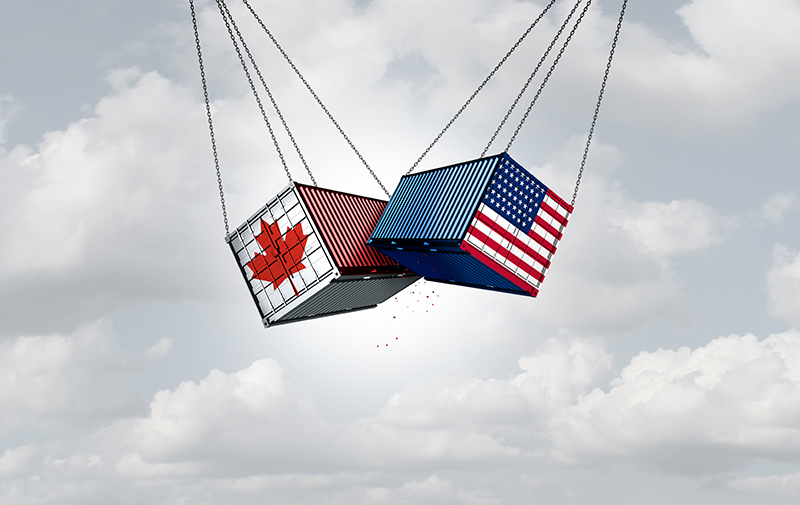Canada’s float and metals’ glass sector could face serious fallout from tariffs

The Canadian glass sector may face serious problems this year due to the recent decision of the U.S. government to set 25% tariffs on the imports of Canadian goods, including glass and architectural metals to the U.S. market. The problem will likely be worsened by counter-tariffs, which have been imposed by the Canadian government.
Canada does not produce float glass, and the country almost completely depends on the supply from the U.S.
The decision of the Canadian government to impose counter-tariffs on imported U.S. float glass to the domestic market means that local producers will face a serious growth of their costs that will have a major negative impact on them and their business. So far, this move has been criticized by many of the representatives and analysts of the Canadian glass sector.
Economists of the Canadian Ministry of Finance predict the tariffs, if left in place, would drive Canada into recession to the tune of a 2.6 percent drop in GDP.
Canadian glass sector criticizes effects of tariffs and counter-tariffs
In an exclusive interview with Adrian Edge, director of codes and regulator affairs for Fenestration Canada—the domestic association representing window and door manufacturers and industry suppliers in Canada—Edge said that Canada would impose counter-tariffs on flat glass, part of the 125B tariffs that were slated to go into effect on April 2. The Canadian government did not end up imposing the tariffs, but has instead offered a potential comment period in the future on additional taxes.
According to Edge, Fenestration of Canada as well as many other industry associations believe the imposition of counter-tariffs will not be useful for the Canadian glass sector itself.
“We are in firm opposition to counter-tariffs as a whole and are specifically targeting our opposition to the glass Harmonized System (HS) codes [a global product classification system],” he says. “Not for sentimental reasons as it pertains to the U.S. relationship, but in the damage that it does to small and medium-sized businesses in Canada and the futility of using counter-tariffs as an effective weapon in a trade war.”
Canada manufacturers consider alternate supply lines
According to Edge, the current situation for the Canadian glass sector remains complex, given that 90% of the glass Canadian manufacturers use comes from the U.S. Glass producers are currently considering alternative options to meet their needs, particularly imports from Asia and some European states, although that will be associated with additional costs and challenges for them.
According to Edge and other Canadian glass analysts and industry representatives, Canada has opportunities to reorient some of its float glass imports to Asia and Europe. However, in the case of Asian imports, this comes with quality/standard issues, while Europe cannot supply enough glass to meet Canadian needs.
As of now, according to open Canadian market data and statistics, Canada has sourced about 4% of its remaining glass from Europe (Turkey and the UK), 5% from Asian markets (primarily China) and the remainder from Mexico. The remaining supply comes from the U.S. Despite the huge additional tax, Canadian manufacturers are expected to continue importing glass from the U.S. given the lack of time and alternative choices for re-building their flat glass supply chain.
According to 2024 data from StatsCanada, the U.S. exported 3,441,808 window units to Canada in 2024.
“If there are, on average, 3 glass units per window, then we're looking at about 10,325,000 glass units [imported] from the U.S.,” says Adrian Edge.
As for European glass supplies, they are estimated at 413,000 units while Asia supplies 516,000 units. These volumes will be insufficient to get the quantity to fill the gap.
Canadian metal industry unlikely to feel the same pinch
In contrast to glass imports, Canada has the ability to manufacture much of its metal supply within the country. Canada applied a "tit for tat" counter-tariff scheme to U.S. steel and aluminum being sold into Canada.
While it’s possible to manufacture metal within the country, it will still be difficult and expensive for manufactures to make the change. “Manufacturers who were bringing in steel reinforcing and aluminum profiles from the U.S. have been working on alternative suppliers for the last month or so,” says Edge. “It's difficult to understand the extent of those changes. For those stuck between redesigning to accommodate the new supply and confirming alternative suppliers, in the short term, they are eating additional costs on contracts that were almost exclusively made before this threat was something manufacturers had thought to include in their risks.”
As for Canadian glass fabricators, in the past most of them were able to ship product to the U.S. with a minimum of bureaucracy because no duties were owed. But since the imposition of duties, most of them will be faced with additional customs procedures and delays that will add additional hours or days to deliveries.
Because of this, many of them will have to find more business in Canada and elsewhere to make up an anticipated drop in U.S. orders. In general, Canada exports some float glass to the U.S., but typically through middleman companies that are buying glass from China/Europe/Middle East. The country currently exports far more aluminum profiles to the U.S. than it does flat glass.
Trade situation revives discussion of reshoring flat glass manufacturing
The threat of a trade war with the U.S. is deepening, while more and more representatives of the Canadian glass community talk about the need to restore Canada’s own float glass production in years to come. That will allow the country to reduce its critical dependence on the U.S. and its supplies.
Canada suspended its float glass production more than 50 years ago although there were some attempts to restore it in the past.
In 2021 Canadian Premium Sand announced plans to build a float glass plant in Manitoba. The company planned to build the plant near its silica sand deposit in the Winnipeg area about 160 kilometres north of Winnipeg in the Wanipigow region.
Canadian Premium Sand considered Winnipeg as one of the best distribution hubs in North America due to its direct access to the U.S. and eastern and western Canada. After its announcement, the company decided to pivot to produce patterned glass for solar panel production.
Xinyi Canada had proposed building a $400-million float glass plant in Stratford, Ontario, that would have provided about 380 jobs, but was met with stern opposition from a small number of residents largely related to concerns about the amount of groundwater that would have been used at the plant, as well as the carbon footprint of the plant.
Also, according to Adrian Edge from Fenestration Canada, some domestic glass fabricators are shutting down plants in order to retool them for solar glass production, due to the increase in the sector's profitability in recent years.
